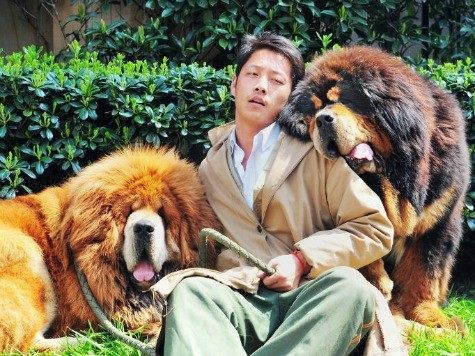The Tibetan mastiff, a large dog breed once so prized among China’s elite that each sold for between $130,000 and $250,000, have become so unpopular that slaughterhouses will pay $5 for them.
Luo Yi, 47, made his millions with home appliances. He decided to open five mastiff breeding farms, home to 600 dogs each, in 2002. Between 2007 and 2012, a dog sold for around $131,000. However, demand and profit went down in 2013, even though one news report claimed a man bought a Tibetan mastiff for $2 million. Luo spent more money to care for the dogs than he made when he sold one. He shut down three farms and fired his workers.
A dog named Nibble and twenty other mastiffs landed on a truck in tiny crates headed to a slaughterhouse. Luckily for the dogs, Beijing animal rights activists threw themselves in front of the truck to rescue all the dogs. They found the dogs in horrible condition, with broken bones and starved. A third of the dogs were already dead in the cages.
“It makes you feel so hopeless because not even the police will help, even though what these people are doing is illegal,” said activist Anna Li.
The natives in Tibet and Qinghai province used the huge dogs “as shepherds and watchdogs.” The dogs are “known for a loyal, but fierce disposition.” The rich in China took a liking to the dogs in the 1990s, which led to overpopulation and inbreeding. The lack of quality, along with “strict regulations against large dogs in cities,” are a few reasons for the dearth of buyers.
“In this way, people in downtown areas of cities including Beijing, Shanghai, and Tianjin have been banned from raising Tibetan mastiffs,” explained Wang Yonggang, chief of Tibetan Mastiff Association in Tibet.
But the breeders are also to blame for the falling market. Some injected silicone into the dogs “to make them look more powerful.” One man sued an animal clinic after his dog died “during face-lift surgery.” Other breeders chose to breed the dogs “with other dogs, diluting the perceived value of the breed and turning off would-be customers.” Despite this, many never thought people would shove mastiffs to the slaughterhouse.
“Ten years ago, it was German shepherds, then golden retrievers, then Dalmatians and then huskies,” said Mary Peng, who founded the International Center for Veterinary Services in Beijing that treated Nibble. “But given the crazy prices we were seeing a few years ago, I never thought I’d see a Tibetan mastiff on the back of a meat truck.”
Luo is one of the few breeders who chose to remain with his dogs while others chose different careers.
“I love to stay with the mastiff dogs, and won’t give up regardless of how low the price is,” he said. “What should be stopped is people’s modern-craze for this holy animal.”

COMMENTS
Please let us know if you're having issues with commenting.